The Yucatan Peninsula
When most people think of the Yucatan Peninsula their first thought is probably of the famous resort town of Cancun, hot winter sun, beautiful beaches, cold cervezas and an escape from the snowy North American winters. As an afterthought some people might also say something like, “I think the Yucatan also has some amazing old Mayan ruins in the jungle”. Well, indeed they do and our priority was to hit the most famous of these sites during our time on the peninsula as well as check out the beautiful beaches and the cold cervezas. Because, after all, this is Mexico.
The Yucatan Peninsula is that very recognisable hook of land that protrudes out into the Gulf of Mexico with its rounded blunt point. It contrasts with the rest of Mexico in that it is jungle while the northern states are dry and desert, it is almost entirely porous limestone which means all rainwater seeps into the ground rather than forming rivers and lakes, it has a very high indigenous population which introduces new cultures, languages, clothes, food and architecture, it has endless sandy beaches and it is chock-a-block with the ruins of ancient Mayan cities which prospered a thousand years ago or more. The Yucatan has it all.
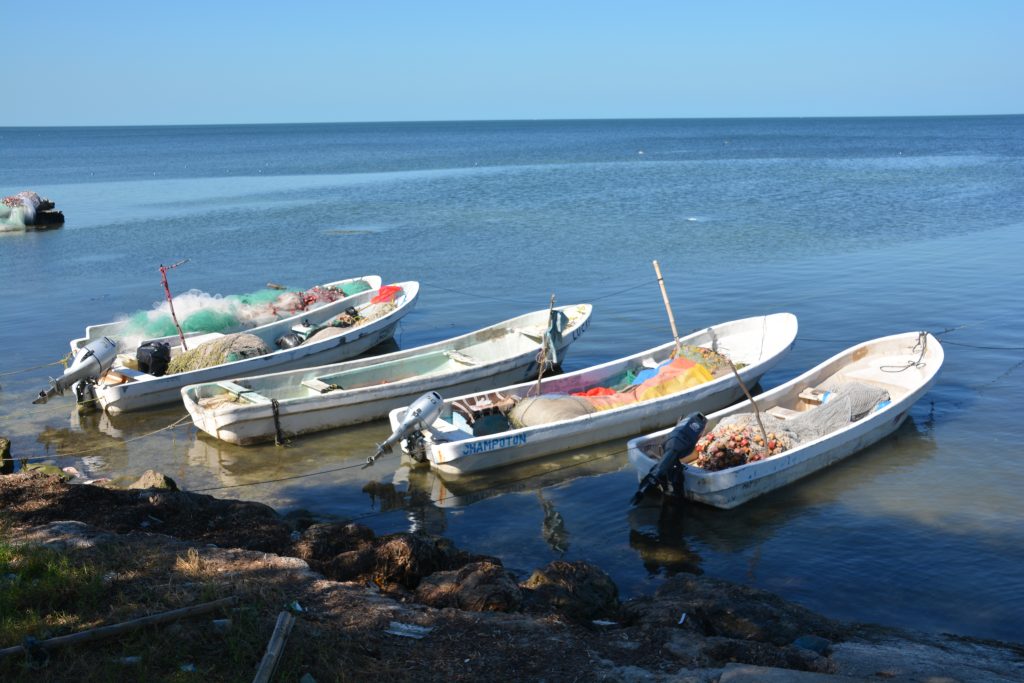
A small fishing port on the north coast featured an endless line of small boats resting up for their duties the next morning
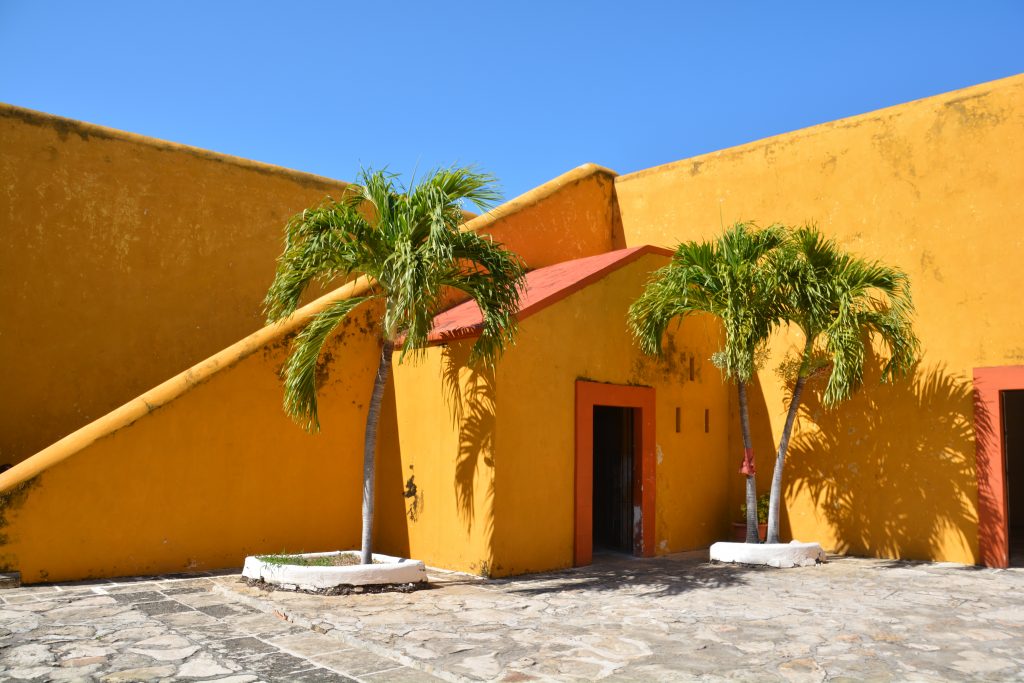
An old Spanish fort built to defend its shores from the Pirates of the Caribbean today features a beautiful coloured courtyard
We drove north from our overnight camp in the jungle near Escarcega to the sleepy seaside town of Champoton where we admired the small fishing boats pulled up onto the rocky shore and the thousands of pelicans which called this coast their home. We followed the coast to the UNESCO World Heritage city of Campeche which the Spanish struggled to maintain as a strategic port against the local Mayan tribes and the swashbuckling pirates of the Caribbean until the 17th century when they built a wall around the old town, one of the few walled towns in all of Mexico.

In the Yucatan we started seeing these grass-roofed ovalish shaped homes with a flat front and back which we think (?) are a Mayan influence
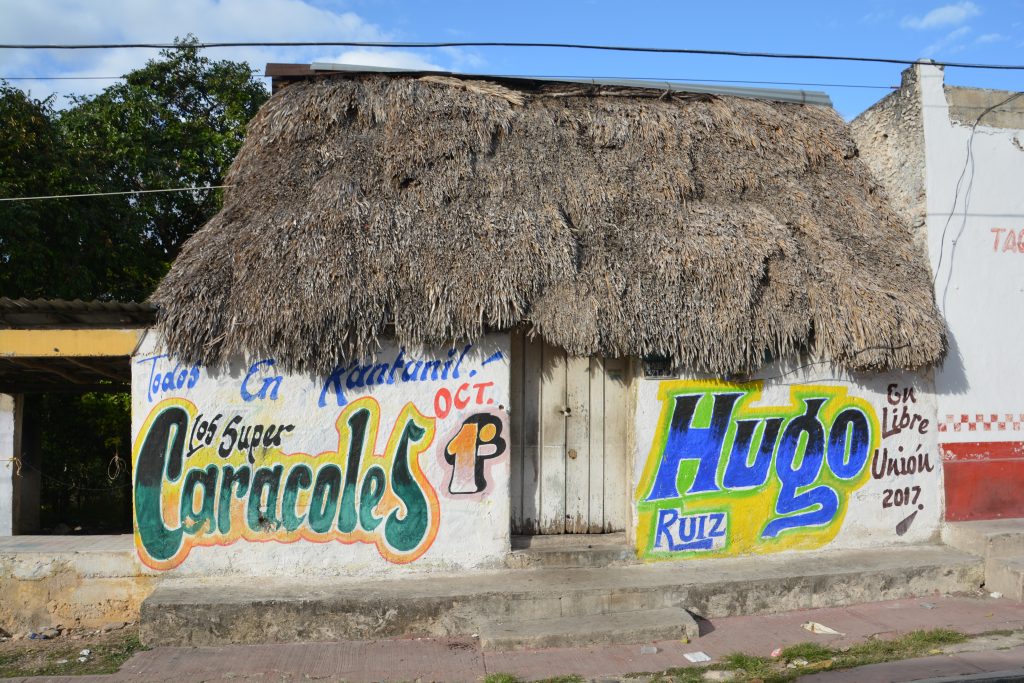
Paid advertising? We’ve been able to look inside some of these to see dirt floors, hammocks for sleeping but the cooking is done outside
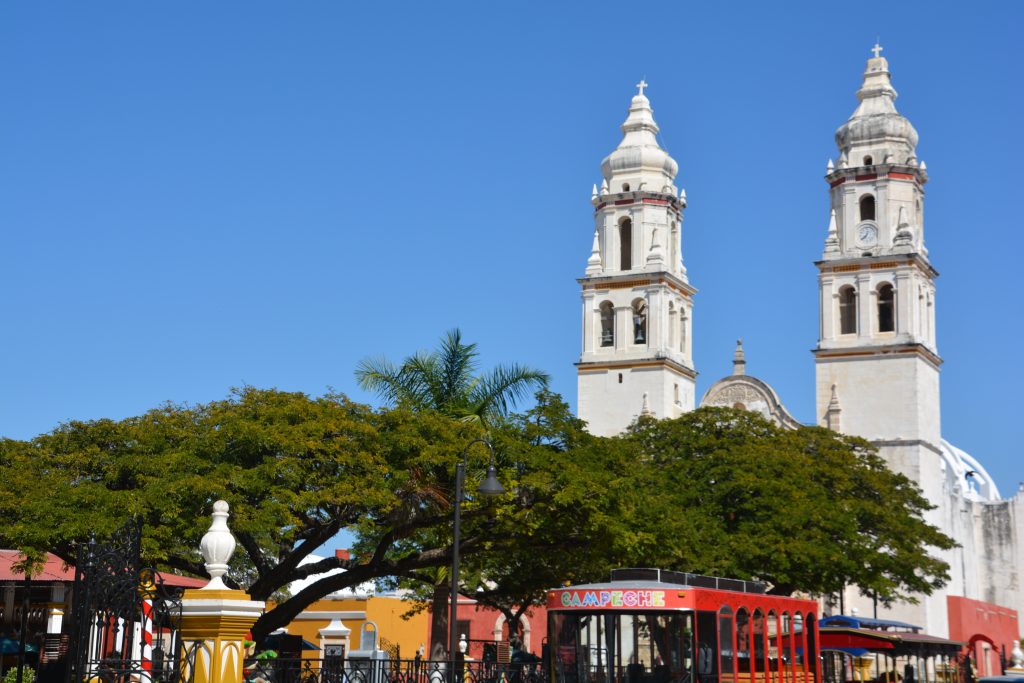
Like most Mexican towns, Campeche featured a large plaza with plenty of trees and shade plus an imposing cathedral overlooking the whole area
Campeche was a lovely place, a wide clean boulevard on the waterfront, a stately old cathedral, brightly coloured buildings featuring all shades of the pastel rainbow, little shops tucked away behind small doors, a main plaza crowded with locals watching the world go by and the remaining sections of the city wall standing guard over the historical centre of town. Campeche gets a big thumbs up.
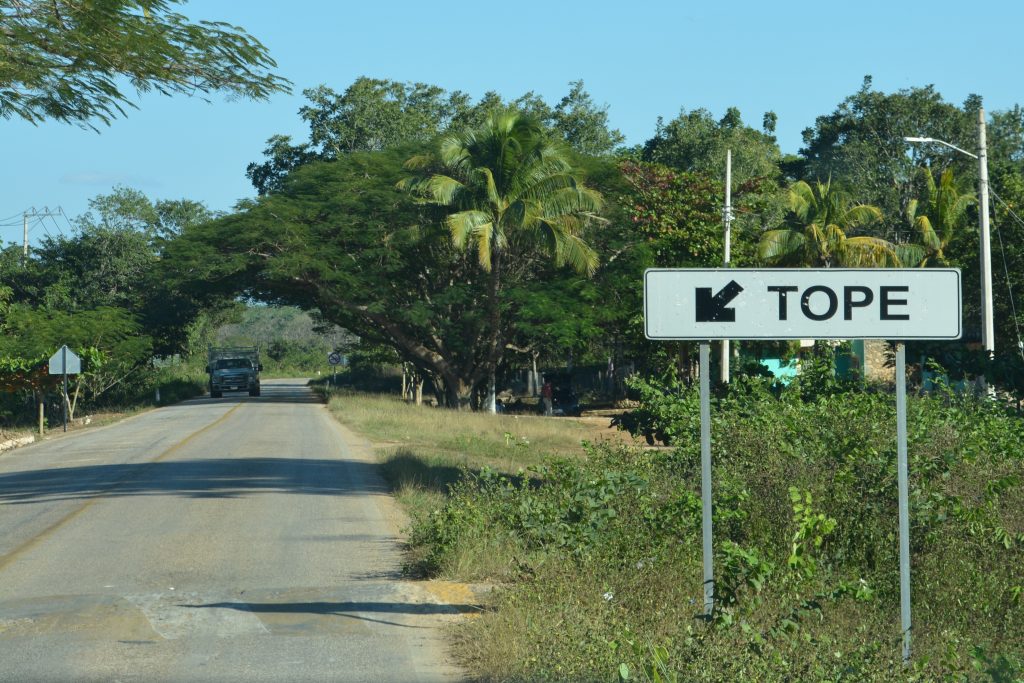
The worst feature of Mexico – Topes, or speed bumps, haunt every road; some are big, some small, some signposted, some not. Beware!
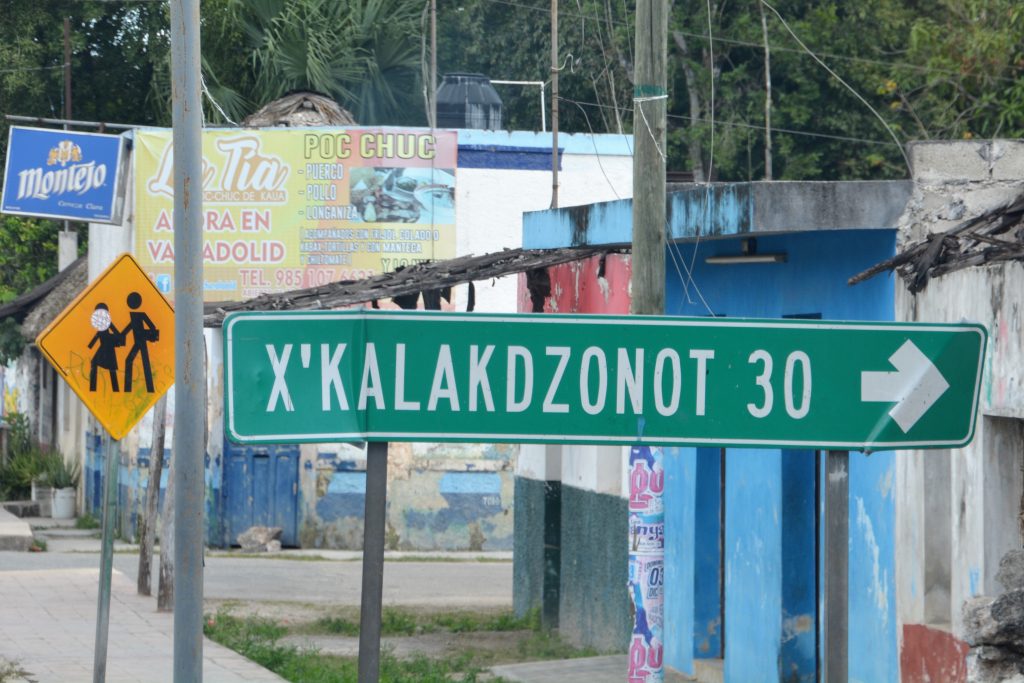
But we loved the Mayan place names – if you didn’t have an X, Z, Q or apostrophe you just didn’t rate…and it was hilarious listening to Karen, our GPS voice, try to pronounce them
But we were headed for Uxmal, one of the Mayan’s largest and most famous cities, tucked away deep in the jungle north of Campeche. To get there we followed secondary roads through small villages, across fields of corn hacked out from the jungle and a few citrus groves featuring mangoes, paw paws, oranges and other fruit. We camped that night in the car park of the Uxmal ruins, with the jungle and its noisy creatures at our back door, a fire to keep us cosy despite another warm evening.
We’ve followed a familiar pattern by now, arriving at the ruins the evening before and spending the first few cool hours of the day walking amongst the remains of these ancient cities with very few people to break the spell. And so it was at Uxmal, one of the Mayan’s main cities from around 600 to 900 with an astonishing collection of detailed carvings on their finest buildings. As we climbed up and down the steep stairs, marvelled at their engineering and architectural triumphs and soaked in the deep jungle atmosphere we couldn’t help but think of what life must have been like in these remote places all those years ago. Amazing stuff.
We drove up to the city of Merida with a few administration issues in mind, including the first service for mighty Tramp. We set that up for the following morning then explored the historical centre of town, ate some traditional Mayan food (excellent) and visited a cooperative store that sells traditionally designed and made clothes by the Mayans in their villages. The key feature of the hats, shirts and blouses of these people is that they are made of sisal which comes from the agave plant.
We camped in the grounds of a nearby hostel and spent the night around the main plaza of the town on the first night of their semi-annual festival to celebrate the Mayan culture. After drinks and dinner enjoyed from a balcony overlooking the buzzing plaza with party lights dangling from the trees and a crowd of people taking in the warm winter night we watched the sound and light show on the façade of their magnificent cathedral. A beautiful evening – we gave Merida high marks.
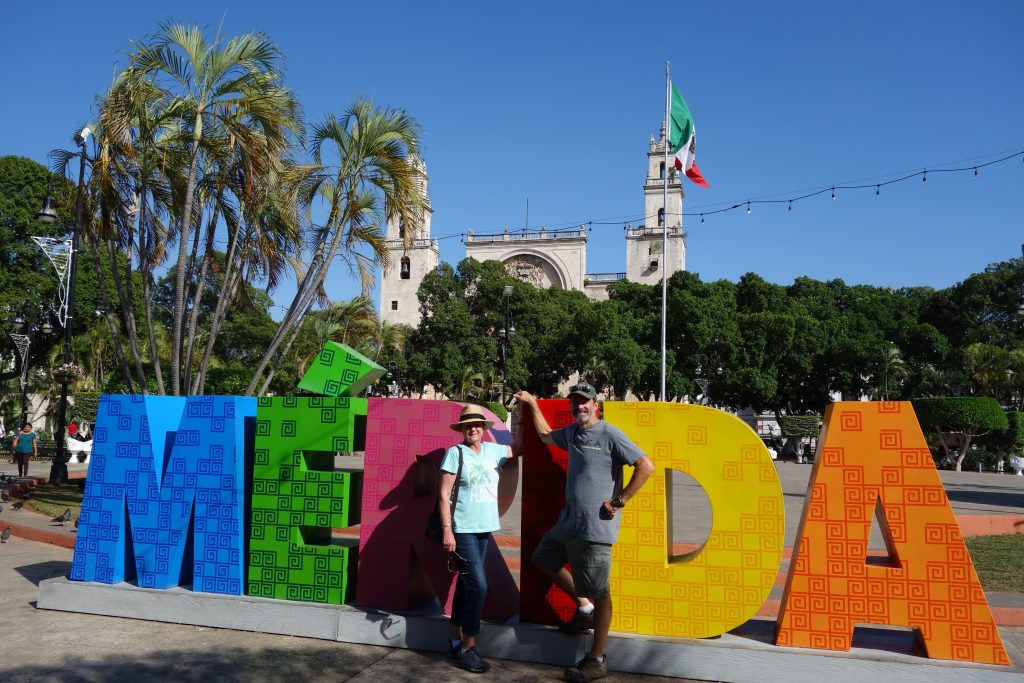
Mexico’s tourism authority hit a home run with their large coloured letters in most cities, sort of like the big red chairs we found all over Canada’s national parks last year
The next day Tramp got his first maintenance check-up at the local Ford dealer. The people there were incredibly friendly – and I had to open Tramp to show everyone how it worked and where we were living – but the whole process took an excruciating five hours. And as a bonus, they found a long screw deeply embedded in the tire that was still suffering from a slow leak. So that tire now has two patches and one plug. Don’t give up on us yet!
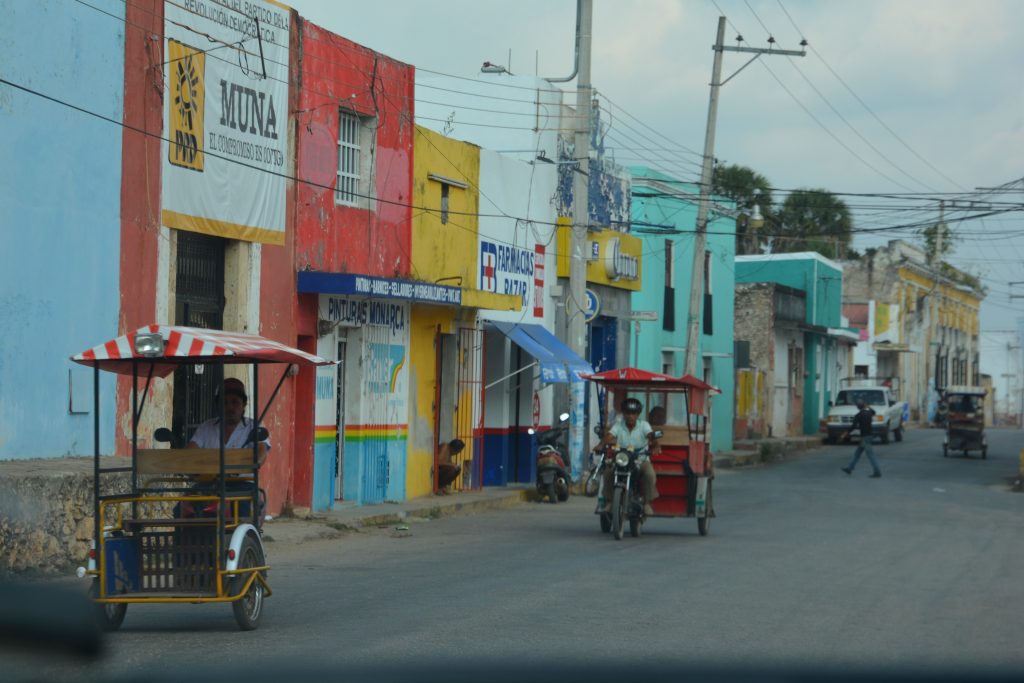
Driving through the little villages have been a real highlight, including the recent inclusion of Asian-style tuk tuks as a major form of local transportation
We then drove a couple of hours on secondary roads to probably the most famous of all Mayan ruins – Chichen Itza. We camped near the entrance of the ruins in a quiet cleared out area of the jungle which is apparently used for overflow parking during peak season. For us it was a quiet home for one night, the pleasant sound of music coming from a nearby village who were enjoying their Saturday night.
Chichen Itza was outstanding. We were about the sixth car in for the and enjoyed walking around these fabulous ruins for the first hour or so before the tour buses arrived. Up to 90,000 Mayans lived in Chichen Itza during its relatively brief reign from about 600 to 900 before other tribes overtook the site. Chichen Itza’s most famous landmark building is El Castillo, the Castle, a perfectly symmetrical stepped pyramid which dominates the site.
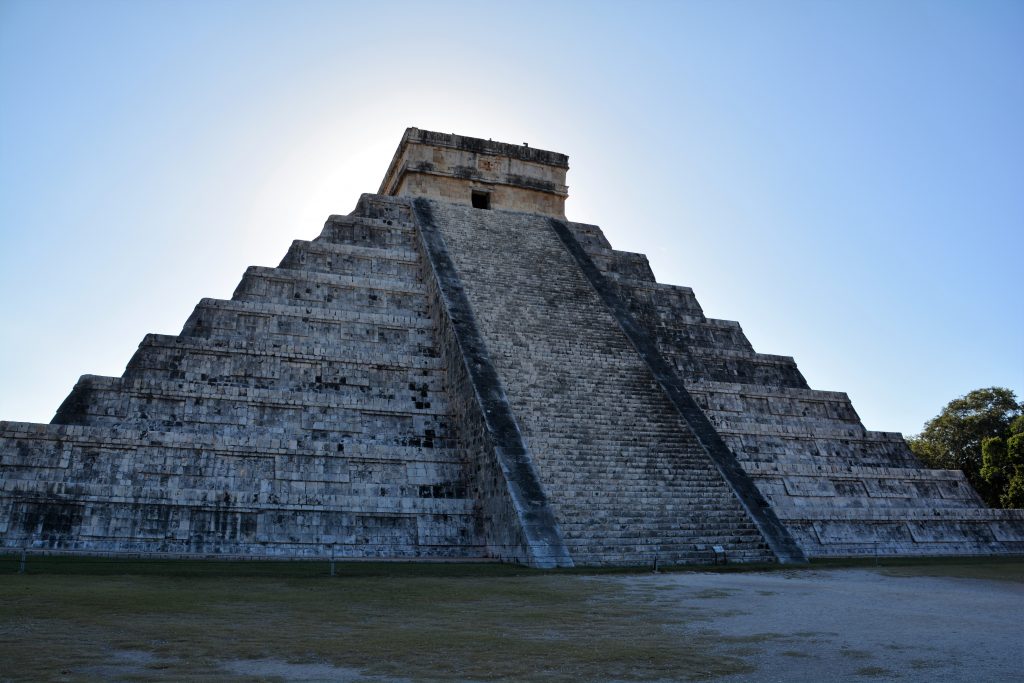
The fabulous El Castillo with the early morning sun rising behind it – probably the quintessential Mayan structure
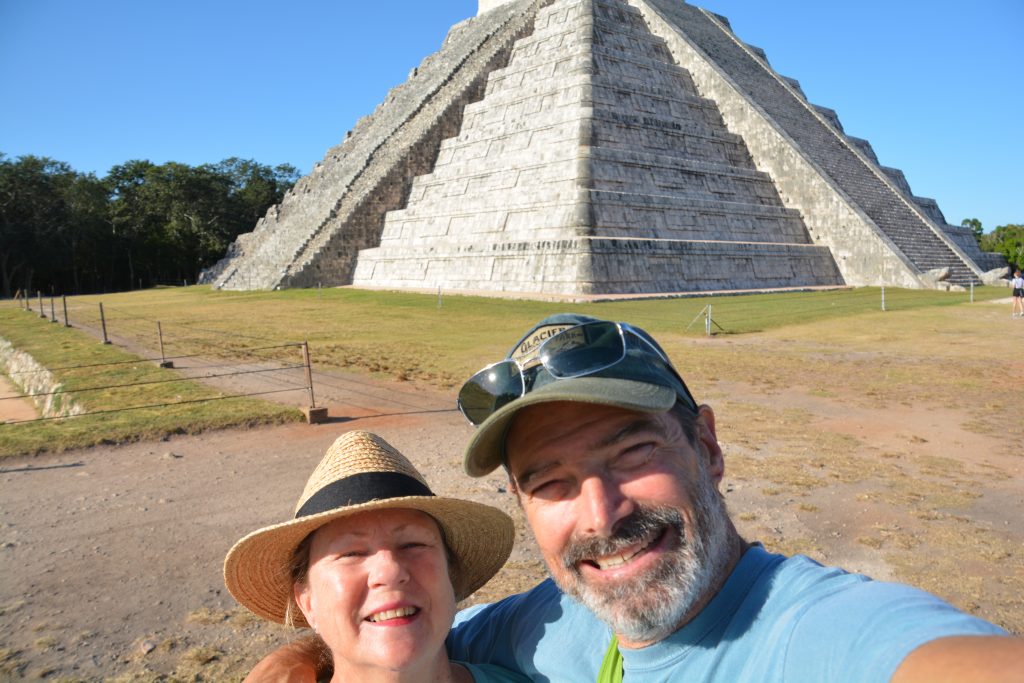
Okay, it was a little big for us to figure out how to get everyone in the photo – this is the best we could do
There were many outstanding buildings, including the Temple of Warriors who’s main feature is the Hall of a Thousand Columns which at one time held up long vaulted ceilings and created a large roofed area. We also enjoyed the Observatory with its unusual round tower and the giant cenote which is a huge sinkhole in the limestone filled with water and the site of thousands of ritual sacrifices and other activities by the Mayans.
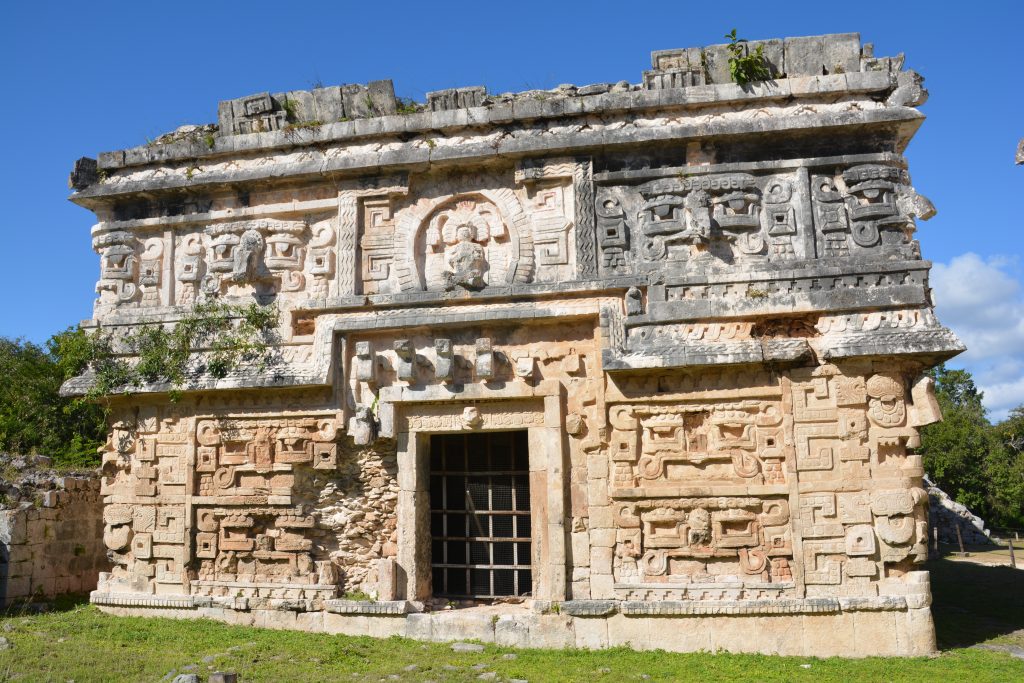
The carvings in these buildings were fantastic, each one telling a story about a particular king or god
There were other temples with some outstanding carvings, skulls, eagles eating human hearts, warriors carrying the heads of their enemies, all great stuff. And of course the locals lined every walkway with rows and rows of a wide variety of things for the tourists to buy and of course we obliged them.
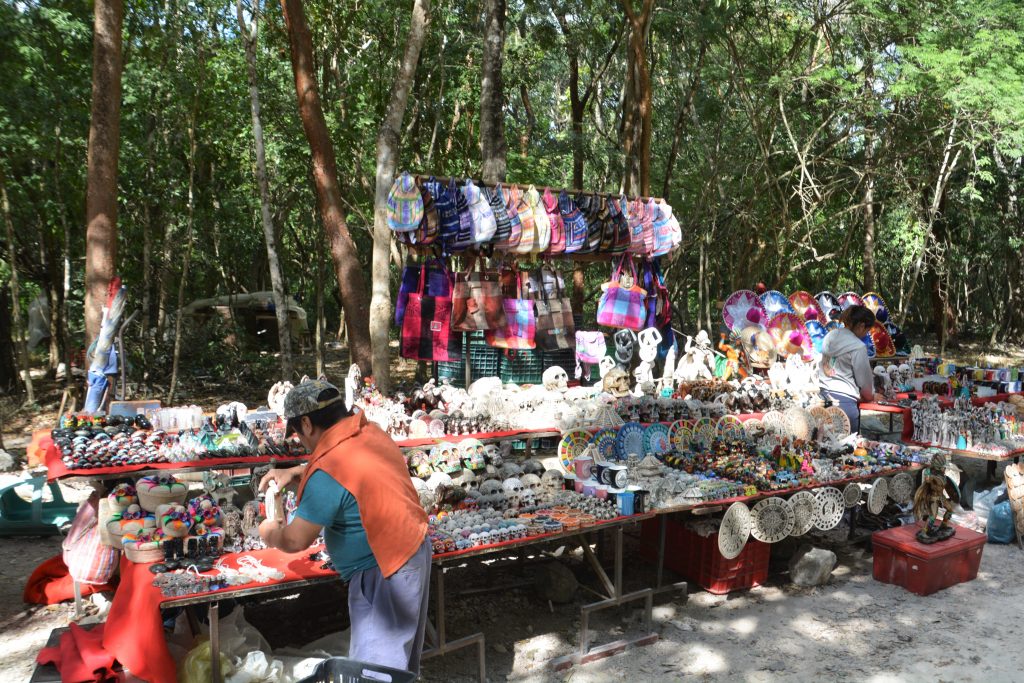
Walking through the jungle between the ruins was like running the gauntlet of endless souvenir hawkers
But other than El Castillo the other standout structure was the giant ball court, a huge structure 135 metres (420 feet) long with high walls and a stone ring on either side. It was here important ball games were played in front of royalty and a roaring crowd with the winning team hitting the ball through the stone ring high on the wall and the losing team becoming the next human sacrifice. Now that’s something to play for!
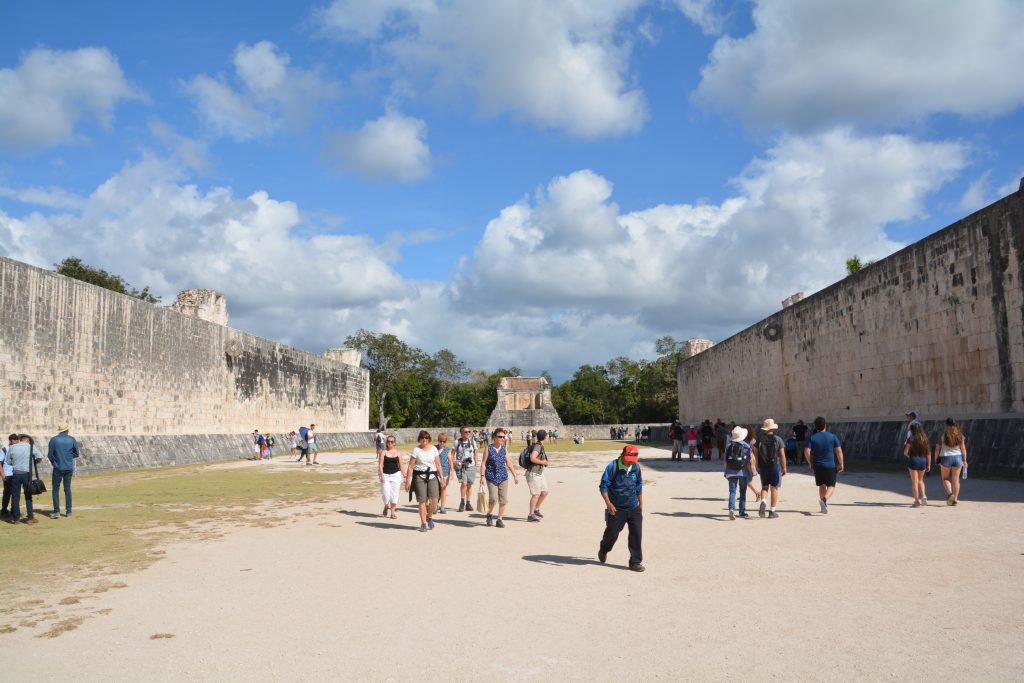
The huge ball court, one of eight at Chichen Itza, much bigger than any modern day football field, where the losers also lost their lives
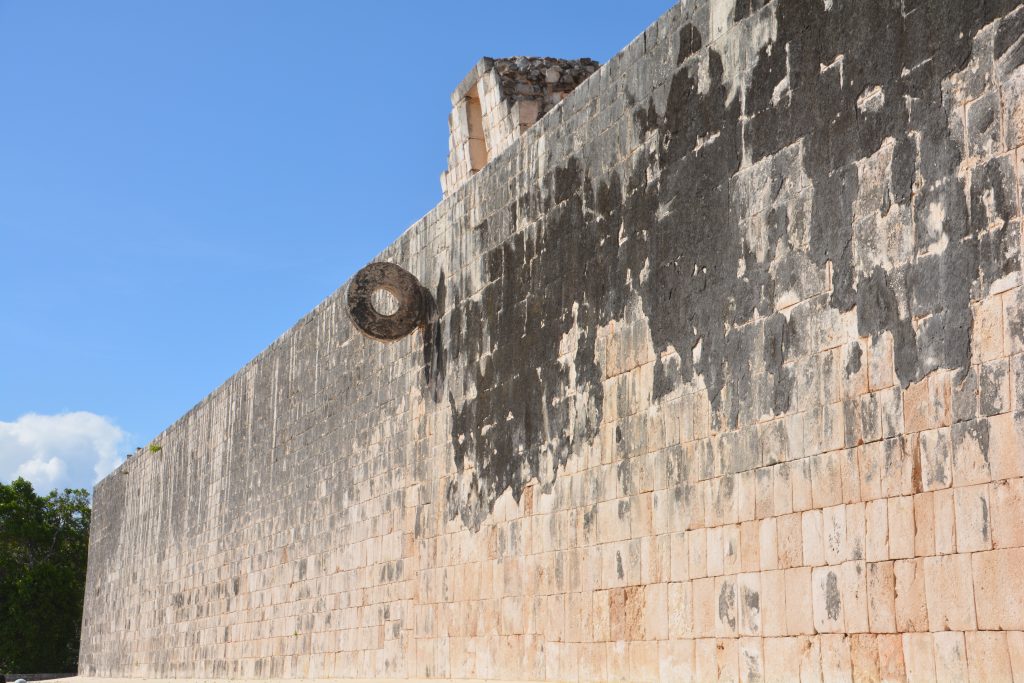
Now how do I hit the heavy rubber ball up through that ring with only my feet, knees and elbows? Its winner take all!
One thing we didn’t like so much after being spoiled at other historic sites is that at Chichen Itza all the ruins, temples and pyramids were roped off and we couldn’t walk on any of them or even in some cases get up close to them. Other sites gave visitors almost unqualified access which has been fabulous but Chichen Itza was the most expensive to enter, had signage that was old and faded and sometimes unreadable, all that plus the lack of access really brought the site down. But to be fair, by the time we left there were thousands of people invading the site so perhaps the authorities were worried about the place being loved to death.
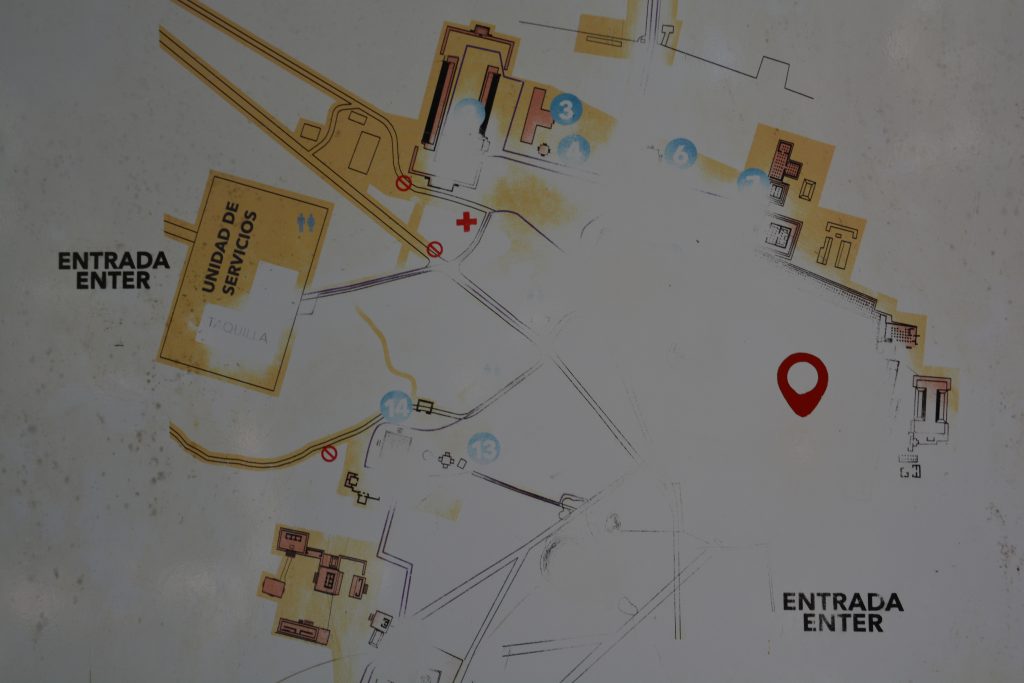
You can’t get lost with one of the worn out maps of Chichen Itza – the red marker indicates ‘You Are Here’
We drove into our last state of Mexico, Quintana Roo (short for Kangaroo) towards Cancun, near the tip of the Yucatan Peninsula. Cancun is famous for its hot sun, sandy beaches, winter escape for freezing North Americans and the premiere party scene for American college students on breaks. We skipped the college party scene and instead camped at a newish campground outside of town and the next morning went into Cancun to see what the world famous fuss is all about.
In fact, Cancun is a game of two halves. The first half is just a normal large Mexican city of about 600,000 people going about their normal lives, almost oblivious to the second half. But once you drive down to the long wide sand spit that runs out and parallel to the city you enter another world – a world of tall western hotel resorts, shopping malls, bars, restaurants, endless souvenir shops and one of the most spectacular beaches we’ve ever seen with almost translucent blue water lapping up on its shore.
We liked the first half of Cancun much more than the string of western hotels with their manicured gardens and fancy names. But we loved the beach. In fact, we loved it so much we found a spot up on a dune above the beach at the southern end of the sand spit and camped for the night, the crashing surf rocking us to sleep. Absolutely bliss.
The next day we did more of the same, errands in town and an afternoon on our gorgeous beach just below where we parked Tramp. We enjoyed the people watching and the pelicans dive bombing into the shallow surf for their supper, we had a beer in one of the little tiki grass huts on the beach and generally took in the whole beautiful scene. The shiny half of Cancun is more than glitzy hotels and sunburn shoulders.
But we had bigger fish to fry and our plan the next day was to fly to Havana Cuba and spend six adventurous days exploring this once forbidden and time-warped country. Fingers crossed with high excitement.
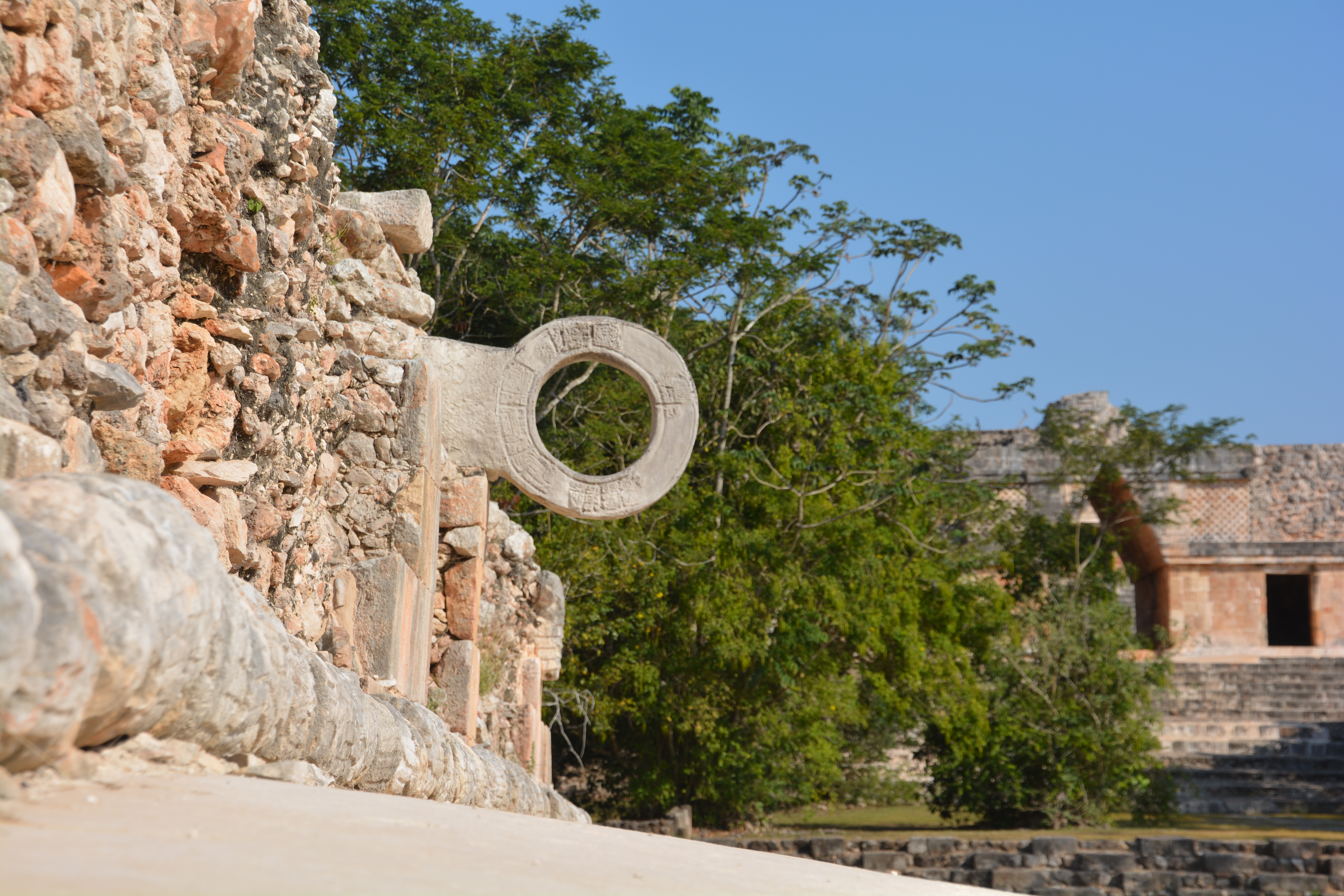













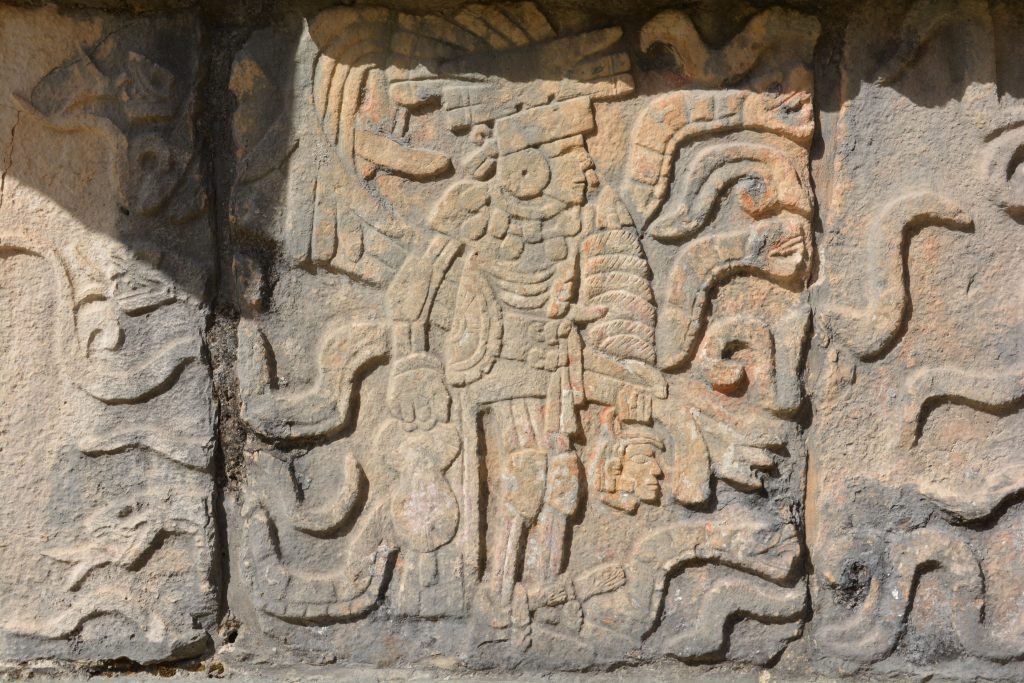








Comments
The Yucatan Peninsula — No Comments
HTML tags allowed in your comment: <a href="" title=""> <abbr title=""> <acronym title=""> <b> <blockquote cite=""> <cite> <code> <del datetime=""> <em> <i> <q cite=""> <s> <strike> <strong>